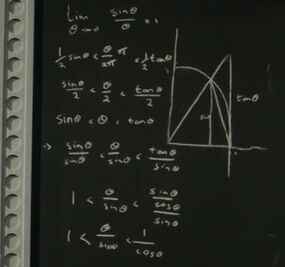1 (number): Difference between revisions
No edit summary |
No edit summary |
||
| Line 9: | Line 9: | ||
According to the [[Second Doctor]], a one in [[13 (number)|13]] chance was about [[7.6923 (number)|7.6923]] [[percentage|percent]], [[odds]] he didn't like. ([[COMIC]]: ''[[Card Conundrum (comic story)|Card Conundrum]]'') | According to the [[Second Doctor]], a one in [[13 (number)|13]] chance was about [[7.6923 (number)|7.6923]] [[percentage|percent]], [[odds]] he didn't like. ([[COMIC]]: ''[[Card Conundrum (comic story)|Card Conundrum]]'') | ||
The Twelfth Doctor once told [[Bill Potts|Bill]] that "[[11 (number)|eleven]] [[sum|plus]] [[2 (number)|two]]" was an [[anagram]] of "[[12 (number)|twelve]] plus one", to which Bill responded that both of these were equal to [[13 (number)|13]]. ([[COMIC]]: ''[[Harvest of the Daleks (comic story)|Harvest of the Daleks]]'') | |||
== Behind the scenes == | == Behind the scenes == | ||
Revision as of 22:44, 5 January 2019
1 was a prime number. (AUDIO: The Haunting)
According to the Tenth Doctor, "Any number that reduces to 1 when you take the sum of the square of its digits and continue iterating it until it yields 1 is a happy number; any number that doesn't, isn't." (TV: 42)
The Twelfth Doctor once proved that . (TV: The Pilot)
According to the Second Doctor, a one in 13 chance was about 7.6923 percent, odds he didn't like. (COMIC: Card Conundrum)
The Twelfth Doctor once told Bill that "eleven plus two" was an anagram of "twelve plus one", to which Bill responded that both of these were equal to 13. (COMIC: Harvest of the Daleks)
Behind the scenes
Though AUDIO: The Haunting establishes that 1 is itself a prime number in the DWU, this is a point of contention among mathematicians.
Generally, 1 is considered neither prime nor composite. It would certainly have been considered a prime, however, in the story's time period of the 1890s. In particular, the entry for Number published in 1890 in the 9th edition of Encyclopædia Britannica stated that every positive number was either prime or composite, and explicitly listed 1 as prime.[1]
Though unremarked in PROSE: Daisy Chain, 1 is also the first and second Fibonacci number.
Footnotes
- ↑ A. Reddick et al. The History of the Primality of One---A Selection of Sources. Accessed at http://primes.utm.edu/notes/one.pdf on 7.12.2015.


